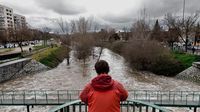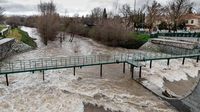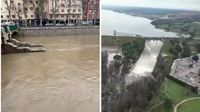As the effects of the recent storm, known as borrasca Martinho, unfold, multiple regions of Spain, particularly Madrid, are bracing for potential flooding and severe weather conditions. The storm, which has already resulted in significant rainfall and strong winds, has prompted the Agencia Estatal de Meteorología (Aemet) to issue weather warnings for nearly all of the country, with the exception of Catalonia, the Valencia region, and Murcia.
The storm's impact has been felt immediately. As of Thursday, March 20, experts warned that areas such as Galicia, Asturias, Cantabria, the Basque Country, and the northwest of Castilla y León could experience the worst of the conditions over the weekend. In fact, the rain over the first half of March has already set records, with the Retiro weather station in Madrid recording 188.2 liters per square meter of rain, a stark contrast from the historical average of 37.3 liters for the month.
Emergencias Madrid alerted residents on March 19 that maximum caution was necessary in the areas surrounding the Manzanares River due to the heightened risk of overflow. Specific roadway precautions were enacted that same evening, as the government decided to close a portion of the M-40 highway near kilometer 25 to prevent potential flooding. The river's water level was critically close to surpassing the highway's limits, which could trigger disastrous flooding in the vicinity.
In Madrid, the government has devised contingency plans to ensure mobility remains feasible on key thoroughfares such as the M-30, M-40, A-6, A-2, and A-5. These roads are crucial as they serve thousands of daily commuters. Francisco Martín, the government's delegate, emphasized that the government is preparing for expected rain and the possible overflow of reservoirs, asking citizens to exercise maximum caution in the coming days.
This storm's effects extend beyond Madrid, particularly in Andalucía where emergencies have skyrocketed. The region has recorded nearly 3,000 incidents as a result of the consistent adverse weather conditions. By March 20, a yellow alert had been issued for five provinces - Huelva, Sevilla, Cádiz, Córdoba, and Málaga - indicating potential for severe storms and flooding due to continued rainfall.
As the storm's winds intensified, they wreaked havoc in places like Cangas, Pontevedra. There, the roof of a local school was blown off, causing disruptions and injuries. In total, two individuals in Pontevedra were injured due to falling trees, while the local authorities continued to address the situation with several roads either threatened or already closed.
In Sevilla, disturbances from the storm prompted the city council to close public parks, recreational facilities, and the municipal cemetery due to safety concerns associated with the severe weather. The emergency services remain on high alert, monitoring river levels closely in anticipation of further uplifts.
Madrid is gearing further to combat the storm's effects. Over the next couple of days, rainfall is expected to intensify, especially by Thursday night into Friday, with forecasters predicting additional snow in the Sierra de Guadarrama. Alongside this, reservoir capacities are precarious, raising concerns about exceeding their physical limits.
Emergency plans were activated by the Junta de Andalucía, particularly in response to concerns regarding flooding in municipalities such as Cantillana and El Palmar de Troya. Essential resources were mobilized to oversee the potential for dangerous situations, ensuring public safety amidst this chaotic weather pattern.
Communities across Spain are being urged to stay cautious and keep informed of updates from local emergency services and government authorities as the storm continues to unfold. With nearly 15 communities under alert for rain, storms, and possible flooding throughout the country, prevention is becoming increasingly critical. Residents are advised to use public transport where possible and avoid unnecessary travel to reduce congestion on roadways.
The storm is not only causing disruptions but is also severely impacting essential services. Traffic delays across major routes in Madrid, along with cut-off access to crucial arterial roads, may impede travel for both emergency services and the general public, complicating efforts to address the consequences of the storm.
This intense situation serves as a reminder of nature's overwhelming power, and the necessity of preparation in the wake of unpredictable weather events. Coordination among local, regional, and national bodies remains vital as awareness and readiness can significantly mitigate the potential fallout of such storms.
In moments like this, where rainfall continues to taper off and significant concerns loom over river overflow and infrastructure stability, maintaining a vigilant communal response is crucial. Moving forward, the weather predictions suggest that the worst may still be ahead as the storm intensifies, urging authorities and residents alike to prepare for continued upheaval in the days to come.
As the storm Martinho makes its presence felt, the collaborative efforts from all levels of government aim to successfully navigate this challenging period. The overarching message emphasizes preparedness, precaution, and unity in responding to the formidable forces of nature.






